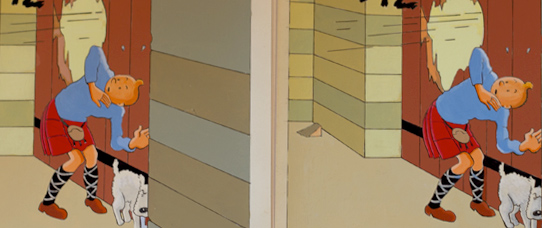
With the production of the stereocards of “Les Aventures de Tintin” it is believed that RoMo was the first company to produce Tintin bandes dessinées in combined colour and stereoscopic format.
In 1957 RoMo contacted Casterman, the publishers of Hergé’s Tintin, to discuss implementation of a series of stereocards, the subject being “Les Aventures de Tintin”. The two companies came to a rapid agreement: RoMo would produce and distribute the stereocards of a Tintin adventure as a set of 12 stereoscopic drawings, using the RoMo stereocard format.
At the start, RoMo would produce a series based on “Tintin in the Congo”, the second of Hergé’s Tintin series. The projects had to be approved with the agreement of Hergé, as did the choice of the various selected images to be used.
In May 1957 RoMo received at its Paris office a file of 4 pages of proposals for 25 stereocards to be developed between RoMo and Hergé’s team. All the images produced were to be approved by Hergé and the choice of the images were to be made by Studio Hergé.
The first set of stereocards were:
The above series were to be the only stereocards cards created.
The artist working with RoMo encountered several problems with the frames proposed and Hergé himself didn’t find the examples proposed particularly convincing. The drawings weren’t done by Hergé himself but his team used the scenes from the books to serve as inspiration for these stereo images. Colour was added to create the 3D effect because the RoMo camera looked through the line drawings, which is believed to to be first time Hergé’s work was coloured for commercial purposes. These drawings weren’t to Hergé’s taste as they weren’t in ‘la ligne claire‘ for which his work is known.
At Christmas time 1957, after many reworking of the images to get the 3D effect working without losing the clarity of Hergé’s artwork, 3 of the images from this series were finished and made available for public purchase, and the other four series were produced and sold in Autumn 1958.
A further 5 Tintin series that the Studio Hergé wished RoMo to make were never realised.
It is estimated that the collaboration between RoMo and Casterman ended in 1960.
The Collection currently holds 202 gouache artworks of the ‘left and right eye’ images that were drawn and painted to be used to create the stereoscopic images, as well as 176 original master positive film images that were used to create the stereocards.